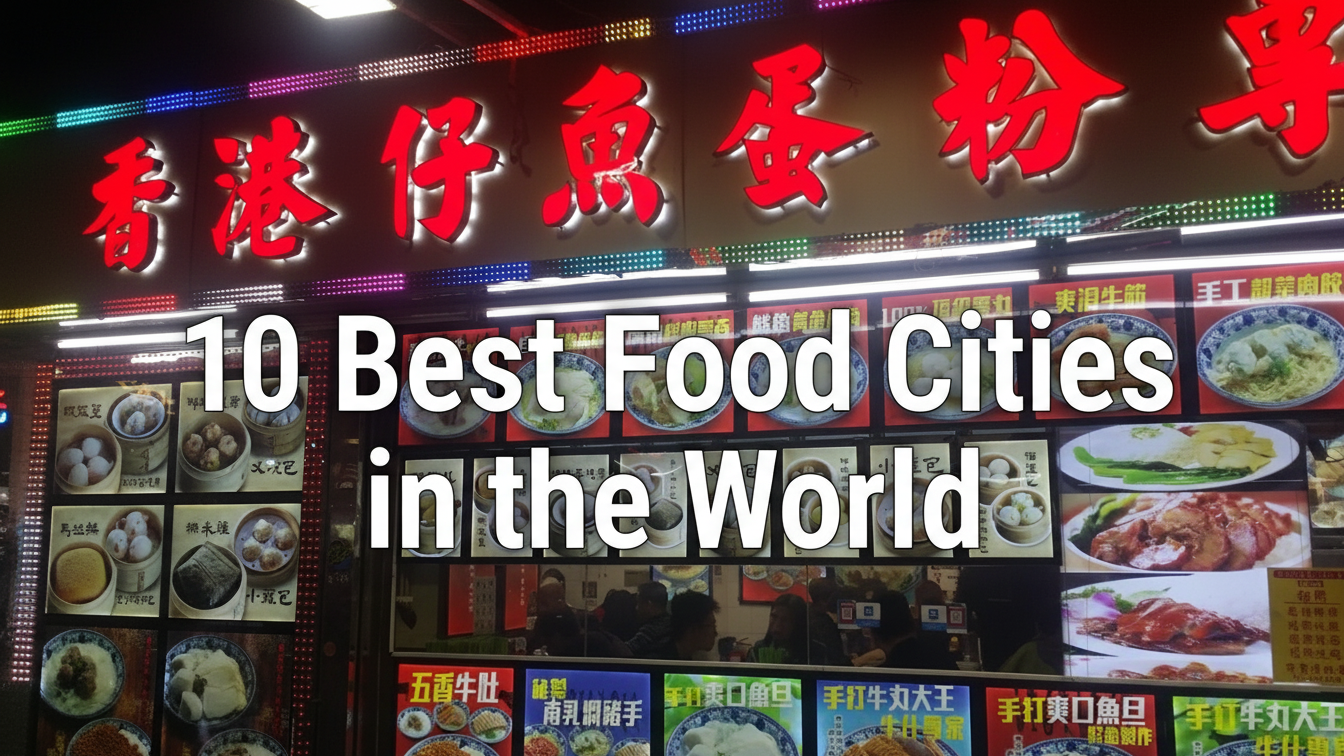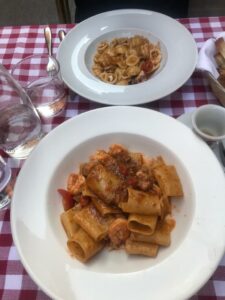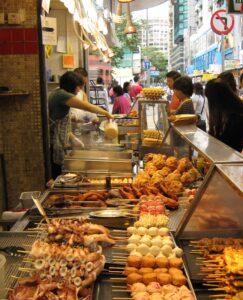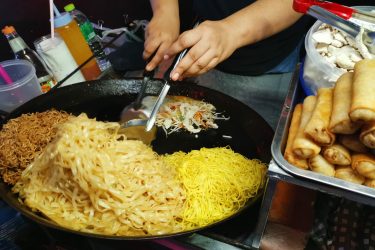There are many different types of delicious food around the world, and some cities are recognized as having the best food in the world. These culinary hotspots combine regional specialties with global influences to create a fusion of flavors that appeals to both local and tourist palates.
These cities not only offer a diverse range of delectable dishes but also embody a cultural ethos that transforms dining into a memorable experience, making them the world’s best food cities.
In this article, we have given you our list of the 10 best food cities in the world. Obviously, this is an exhausted list and was hard to only mention 10 cities, but we feel after experiencing these cities first-hand and all the research we have done that we are satisfied and happy to give you are top 10 cities that you should definitely check out if you are a foodie.
Bologna, Italy
The Italian city of Bologna is known for its extensive culinary history and is sometimes referred to as “La Grassa” or “The Fat One.” The city’s food culture is steeped in history and provides a gastronomic experience that embodies true Italian cuisine.
Pasta is one of Bologna’s best-kept culinary secrets, and the city is renowned for its tagliatelle al ragù, or Bolognese sauce as it is known outside of Italy. Serve the generously portioned sauce over wide, flat ribbons of freshly made pasta. The sauce is a slow-cooked mixture of minced meat, tomatoes, onions, and aromatic herbs. The preparation of this dish is a source of pride for the locals, as the recipes have been handed down through the generations.
Tortellini, which are small pasta parcels stuffed with a flavorful blend of cheeses, meats, or vegetables, originated in Bologna as well. These little gems are frequently served with a basic sauce or in a cozy broth.
Bologna is the birthplace of mortadella, a cured pork sausage that is popular among meat eaters. Slated in sandwiches or as an accompaniment to antipasti, it epitomizes the city’s commitment to premium, handcrafted cured meats.
The Quadrilatero, a charming market district in the center of Bologna, is brimming with vendors selling handmade pasta, cheeses, meats, and fresh produce. Discovering this region offers a sensory extravaganza, enabling guests to fully experience the sights, sounds, and scents of real Italian cuisine.
Bologna’s cuisine is not just savory; sweet tooth’s will be tempted by sweets like rice cake, or torta di riso, and trifle-like layered dessert, zuppa inglese.
All things considered, Bologna’s culinary scene celebrates simplicity, high-quality ingredients, and time-tested recipes, creating a gastronomic paradise that invites both residents and tourists to experience the very best of authentic Italian cuisine.
If you would like to know Best Things to Do and See in Bologna, click here go to our post where you will receive the best information and some of our recommendations.
Rome, Italy
Italy’s capital city of Rome is home to a thriving culinary scene that is influenced by tradition, history, and the art of slow, flavorful cooking. A trip through Rome’s food scene is an exploration of Italian cuisine at its core.
Pasta is a staple of Roman cooking, with dishes like carbonara (pasta with eggs, cheese, pancetta, and black pepper) and cacio e pepe (pasta with cheese and pepper) taking center stage. Romans are known for their pasta, and they frequently insist on making it with premium, regional ingredients and age-old recipes.
It is impossible to discuss Roman cuisine without bringing up pizza. Pizza may have originated in Naples, but Rome has its own distinct style. Roman pizza is known for its thinner crust. Popular types include the traditional Margherita and the more complex pizza bianca, which is made with olive oil, salt, and occasionally rosemary and is quite tasty.
A deep-fried rice ball filled with tomato sauce, mozzarella, and occasionally ground meat is called a supplì, a specialty of Roman street cuisine. This snack embodies the city’s fondness for salty, on-the-go snacks.
The nose-to-tail philosophy of Roman cuisine is evident in dishes like coda alla vaccinara, or oxtail stew, which highlights the city’s dedication to minimizing waste and maximizing flavor. A favorite dish in the area, artichokes are prepared in a variety of ways, but “carciofi alla romana” is particularly good; it’s slow-cooked with garlic and herbs.
Eating is a social and cultural event in Rome that involves more than just the cuisine. Locals eat slowly, enjoying each bite and striking up lively discussions during their meals. Robust red wine is often served with a Roman supper to bring the flavors of the food and the warmth of the conversation together.
Food in Rome is a celebration of family, life, and the timeless pleasures of delectable, traditional dishes consumed in a city where there is a tale of outstanding cuisine to be found around every corner.
If you would like to know Biggest Tourist Attractions in Rome, click here go to our post where you will receive the best information and some of our recommendations.
Osaka, Japan
Known as the “Kitchen of Japan,” Osaka has a thriving and varied food culture that is a testament to the city’s past as a significant economic and culinary center. Osaka provides a mouth-watering culinary experience and is well-known for its street food, regional specialties, and love of robust flavors.
Takoyaki, savory balls filled with octopus that are cooked in a unique round mold using a batter of wheat flour, eggs, and dashi, is one of the signature dishes connected to Osaka. Takotoki sauce, bonito flakes, and seaweed are frequently added to these mouth-watering street snacks, resulting in a delightful umami explosion.
Another Osaka favorite is okonomiyaki, also known as “Japanese pizza” or “Japanese pancakes.” With ingredients like cabbage, meat, seafood, and noodles, all cooked on a griddle and drenched in a unique okonomiyaki sauce, this savory pancake is a customizable delight.
Kuromon Ichiba Market, Osaka’s street food district, is also well-known. Here, vendors sell a wide variety of mouth-watering goods, including yakitori (grilled chicken skewers), kushikatsu (deep-fried skewers), and fresh seafood of every kind.
The city’s passion for street food is evident in busy neighborhoods like Dotonbori, where the air is filled with the tantalizing smell of grilled food and the streets are lit up by neon lights. There are many different restaurants in this area that serve everything from traditional sushi made in Osaka to contemporary takes on traditional meals.
The idea of kuidaore, or “eat until you drop,” is central to Osaka’s food culture. People in the city take great pleasure in enjoying life through food, and this passion for food is reflected in the vibrant atmosphere. Discover the essence of Japanese culinary creativity and hospitality through a gastronomic adventure that Osaka’s food culture invites you to partake in, whether you’re exploring bustling street corners, modern food markets, or historic districts.
Try Amazing Cuisine in Hong Kong
Hong Kong’s culinary scene is a colorful and varied tapestry that reflects the distinct fusion of Cantonese, British, and foreign influences in the city. Hong Kong, well-known as a center of the world’s cuisine, provides an incredible variety of foods to suit every taste and preference.
A mainstay of Hong Kong’s culinary scene is dim sum, which is served in little steamer baskets and consists of bite-sized portions of both savory and sweet treats. Both tourists and residents appreciate the creativity and flavors of these delicious little bites, whether they are consuming traditional dim sum at a teahouse or discovering contemporary takes on traditional recipes.
Street food in Hong Kong is legendary, with a wide variety of mouth-watering snacks available from roadside stalls and busy markets. The smells of a wide variety of reasonably priced culinary treats fill the streets, from fish ball skewers and foul-smelling tofu to egg waffles and pineapple buns.
A trip to a cha chaan teng, a traditional café, is a must if you want to see Hong Kong’s distinctive blend of East and West. These restaurants offer a variety of Western foods prepared in the Hong Kong style, including macaroni soup with ham, pineapple buns with butter and Hong Kong milk tea.
Hong Kong’s cuisine is heavily reliant on seafood, and markets that float, such as Lei Yue Mun, provide an immersive experience where diners can select live seafood for their meal. Specialty meals like salt and pepper squid and typhoon shelter crab highlight the city’s passion for flavorful, fresh seafood.
Hong Kong offers a wide variety of Michelin-starred restaurants that serve everything from traditional Chinese food to modern international cuisine, perfect for those seeking a taste of luxury. These gastronomic havens dot the skyline of the city, offering not only great food but also breath-taking views.
In the end, Hong Kong’s food culture is an exciting blend of innovation and tradition, where great food is enjoyed in a variety of venues, from classy fine-dining restaurants to modest street corners. This diverse range of cuisines adds to Hong Kong’s standing as the world’s foodie haven.
If you would like to know Top 10 Tourist Attractions in Hong Kong, click here go to our post where you will receive the best information and some of our recommendations.
Beijing, China
China’s capital, Beijing, is home to a thriving culinary scene that is strongly influenced by its past. The city is a food lover’s dream come true because of its exquisite fusion of traditional flavors, imperial influences, and contemporary innovations.
One of the mainstays of Beijing’s culinary traditions is Peking duck, a delicacy with imperial origins. Peking duck is roasted to perfection, and its crispy skin and succulent meat are usually served with sliced scallions, hoisin sauce, and thin pancakes. It’s a dining experience that captures the culinary heritage of the city.
Jianbing is another well-known Beijing dish; it’s a savory pancake that’s typically eaten for breakfast. Street corners and crowded markets are home to jianbing vendors who expertly spread a batter on a griddle, crack an egg on top, add a variety of fillings such as pickled vegetables, crispy fried dough and hoisin sauce, and then fold the pancake into a portable and delicious package.
Snack streets in the city, like Wangfujing Snack Street, provide a wide selection of regional specialties. Among the strange options that entice daring diners are deep-fried scorpions, sugar-coated haws on sticks, lamb skewers, and stinky tofu.
Traditional tea houses in Beijing offer a calm environment for experiencing the Chinese custom of drinking tea, which is very deeply ingrained in the culture. In addition to serving an assortment of teas, teahouses also provide a selection of snacks and dim sum to enhance the tea-drinking experience.
Beijing has embraced foreign culinary influences in recent years, and as a result, a wide variety of international cuisines are currently available in the city’s dining scene. The city maintains its long-standing culinary traditions while appealing to a cosmopolitan clientele with its chic fusion restaurants and upmarket international dining options.
All things considered, Beijing’s food culture is an enthralling trip through time, where traditional recipes blend with modern culinary styles to provide a vibrant and fulfilling experience for anyone keen to sample the city’s culinary offerings.
If you would like to know Top Things to Do in Beijing, click here go to our post where you will receive the best information and some of our recommendations.
Bangkok, Thailand
Bangkok, the energetic capital of Thailand, is well known for its varied and delicious food culture and is considered a culinary paradise. The aroma of Thai spices fills the air as you walk around the city, and the vibrant markets and food stands serve a wide variety of dishes that showcase the nation’s extensive culinary legacy.
Pad Thai is a traditional Thai dish that has become internationally recognized. The perfect balance of sweet, salty and sour flavors that characterize Thai cuisine is captured in this dish of stir-fried noodles, which is usually made with rice noodles, prawns, tofu, peanuts and lime. Pad Thai is the epitome of the delectable simplicity of Thai street food, whether it is eaten from a street vendor or at a fine dining establishment.
Green papaya salad, or som tum, is another well-known Thai dish that perfectly captures the strong, crisp flavors of the nation. Som Tum is a zesty and spicy salad that embodies the Thai penchant for harmonizing sweet, sour, salty, and spicy tastes. It is made with shredded green papaya, tomatoes, chilies, lime, and fish sauce.
A vital component of Bangkok’s culinary culture is the street food scene. Street vendors sell a wide variety of delicious snacks, such as crispy spring rolls, coconut-infused desserts, and skewers of grilled meats and seafood. Bangkok becomes a nocturnal food paradise at night thanks to the vibrant night markets like Asiatique and Rod Fai, where visitors and locals alike can indulge in a wide variety of Thai
Vendors offer a distinctive dining experience at the city’s traditional floating markets, such as Damnoen Saduak, where they sell their wares from boats cruising the canals. Come here to enjoy freshly made Thai food, such as grilled delicacies, boat noodles, and coconut ice cream.
Bangkok is known for its food culture, which is evident in its thriving fine dining scene. Gaggan, Nahm, and Bo.Lan are just a few of the restaurants that have gained international recognition for their creative takes on Thai cuisine. These restaurants highlight Bangkok’s ability to slickly combine traditional and contemporary cooking methods, making it a must-visit location for foodies keen to sample Thailand’s wide range of flavors.
If you would like to know Street Food In Thailand, click here go to our post where you will receive the best information and some of our recommendations.
Seoul, South Korea
The vibrant food culture of Seoul, the dynamic capital of South Korea, skillfully combines tradition and innovation. Street markets and fine dining venues are just two of the city’s many culinary attractions that highlight the rich diversity of Korean cuisine.
The traditional Korean barbecue, a communal meal where diners grill a variety of meats at their table, is the focal point of Seoul’s culinary scene. With dishes like galbi (short ribs), samgyeopsal (pork belly), and bulgogi (marinated beef), barbecue restaurants are all over the city. Korean barbecue, served with a variety of banchan (side dishes) and wrapped in lettuce leaves, captures the lively, conversational atmosphere of Seoul’s dining scene.
In Seoul, street food is an essential part of the culinary scene. The lively markets of the city, like Myeongdong Street and Gwangjang Market, are brimming with vendors selling a wide variety of delicacies, including odeng (fish cake skewers), hotteok (sweet pancakes), and tteokbokki (spicy rice cakes). Street foods like these encapsulate the essence of Korean flavors by fusing savoury, spicy, and sweet ingredients to create a mouth-watering experience that appeals to both locals and tourists.
A mainstay of every Korean meal, kimchi is a dish of fermented cabbage that is unique to Korea and represents the nation’s culinary identity. Seoul’s culinary scene has embraced a range of kimchi varieties, such as cucumber and radish kimchi, in addition to the classic Napa cabbage kimchi, demonstrating the versatility and inventiveness of Korean food.
Seoul’s culinary scene offers more than just traditional meals; modern and fusion cuisine is becoming more and more popular. Creative chefs are taking traditional recipes and fusing them with other cultures to create new and exciting takes on Korean cuisine. This blending of tradition and innovation is best demonstrated by eateries such as Jungsik and Mingles, which provide modern takes on Korean cuisine with a chic twist.
Dining in Seoul is a cultural experience that showcases the city’s inventive cuisine and dynamic energy, rather than just a means of subsistence. The vibrant street markets and sizzling barbecue restaurants in Seoul encourage everyone to indulge in the varied and delightful flavors of South Korea.
Tokyo, Japan
Tokyo, the vast metropolis of Japan, is a gourmet paradise where traditional and contemporary cuisine coexist harmoniously. Food enthusiasts will find heaven in the city, as its food culture is a dynamic blend of creativity, precision, and a deep respect for ingredients.
Tokyo offers a wide variety of street food, which can be found in busy areas like Shibuya and Asakusa, and is one of the city’s culinary highlights. The delicious street foods that tempt locals and tourists alike include takoyaki (octopus balls), yakitori (grilled chicken skewers), and taiyaki (fish-shaped pastries filled with sweet or savory fillings). Tokyo’s street food scene is a celebration of tastes, textures, and the skill with which Japanese snacks are made.
In Tokyo’s culinary scene, washoku, or traditional Japanese food, is highly regarded. The artful preparation of sushi, sashimi, and tempura brings out the inherent flavours of the ingredients. When looking for the freshest catches of the day, seafood lovers will find paradise at Tsukiji Outer Market with its sushi stalls and seafood vendors. Another culinary gem that lets diners experience the essence of Japanese aesthetics and seasonality is kaiseki, a multi-course meal that skilfully balances taste, texture, and presentation.
Tokyo is also a centre for culinary innovation worldwide, home to many Michelin-starred eateries that are pushing the limits of conventional Japanese fare. Tokyo’s position as a leader in the global culinary scene is demonstrated by these restaurants, which feature everything from molecular gastronomy to modern takes on traditional dishes.
Tokyo’s food culture gains a social and convivial dimension from izakayas, traditional Japanese pubs. Locals congregate here after work to enjoy sake, share small plates, and take in the vibrant atmosphere. The experience is proof of Tokyo’s dedication to both fine dining and communal eating.
Tokyo’s rich history and ongoing innovation are reflected in the food, which is more than just a source of nourishment—it’s also an artistic medium, a means of cultural expression, and a communal experience. Everyone is welcome to take a culinary voyage through the heart of Japan with Tokyo’s food culture, which ranges from the modest street vendors to the Michelin-starred restaurants.
Hue, Vietnam
The rich culinary culture of Hue, the former imperial capital of Vietnam, is a reflection of the city’s royal heritage and the wide range of historical influences. Hue, known for its imperial cuisine, provides a gastronomic experience that combines tastes, aesthetics, and cultural customs in harmony.
Once reserved for the imperial court, Hue’s distinctive royal dishes are at the heart of the city’s culinary culture. These elaborate creations highlight the city’s chefs’ deft craftsmanship. The signature Hue-style rice cakes, or banh hue, are made with thin sheets of rice flour filled with a variety of ingredients, like pork and prawns, and expertly folded into beautiful shapes. Every morsel pays homage to the sophisticated palate of Vietnam’s imperial era.
Bun Bo Hue, a tasty noodle soup that captures the intense and fiery flavours of central Vietnamese cuisine, is another culinary treasure. This dish, which combines fermented prawn paste, lemongrass, and beef, demonstrates the region’s love of strong, flavourful foods.
Hue has a very interesting street food scene with a variety of regional specialties. Vendors at the lively Dong Ba Market create delectable treats like grilled pork skewers and crispy rice pancakes, or Banh Khoai. These street foods encapsulate both the warmth of the Vietnamese people and their exceptional culinary skills.
Vegetarianism is another unique ritual that characterises the city’s food culture, especially during the annual Hue Festival. Both locals and devotees practise vegetarianism, which has resulted in an abundance of vegetarian dishes that highlight the culinary inventiveness of Hue’s chefs in creating mouth-watering meat substitutes.
Hue’s street food scene exudes a lively energy that is combined with bold flavors and royal refinement, creating a tapestry of food culture. Hue’s culinary offerings offer a journey into the heart of Vietnam’s cultural and historical richness, whether you choose to indulge in the simplicity of street eats or savor royal delicacies.
Paris, France
Paris, which is frequently referred to as the world’s culinary capital, has a distinctive and varied food culture. Though it has strong roots in tradition, the city’s cuisine is always embracing innovation and outside influences.
Parisian cuisine is centered around French cuisine, which is recognized for its focus on premium ingredients and careful preparation. Every dish, from the rich escargot and coq au vin to the buttery croissants and flaky baguettes, narrates a tale of culinary skill. A variety of flavors are available in the city’s bistros, brasseries, and Michelin-starred restaurants, pleasing both the picky diner and the casual food enthusiast.
Paris is known for its fresh produce and locally sourced ingredients, which is best demonstrated by its vibrant markets like the Marché des Enfants Rouges. Wandering around these markets reveals colorful displays of cheeses, charcuterie, seasonal produce, and fruits that entice locals and tourists to experience the true flavor of French terroir.
Parisian culture revolves around the café culture. Locals congregate in pavement cafés, such as the iconic Les Deux Magots and Café de Flore, as social gathering places while sipping espresso or wine. These places perfectly capture the romance and intellectual appeal of Paris.
Another distinguishing feature of Parisian cuisine is diversity. Due to the city’s diverse population, a wide variety of international cuisines have emerged. The variety of options available in neighborhoods such as Belleville and Le Marais, such as Moroccan tagines and Vietnamese pho, reflects the global influences that have enriched Parisian gastronomy.
Parisians also take pleasure in food-related celebrations, like the yearly Fête de la Gastronomie, which features tastings, seminars and other culinary events all over the city. The focus on food as a fundamental component of culture highlights Paris’s dedication to maintaining and enhancing its gastronomic legacy.
Essentially, Parisian cuisine is a well-balanced fusion of global influences, innovation, and tradition. It is a constantly changing celebration of taste, creativity, and the pure joy of savoring superb food surrounded by the charming streets and famous sites of the City of Light.
If you would like to know What to Do and See in Paris, click here go to our post where you will receive the best information and some of our recommendations.


















